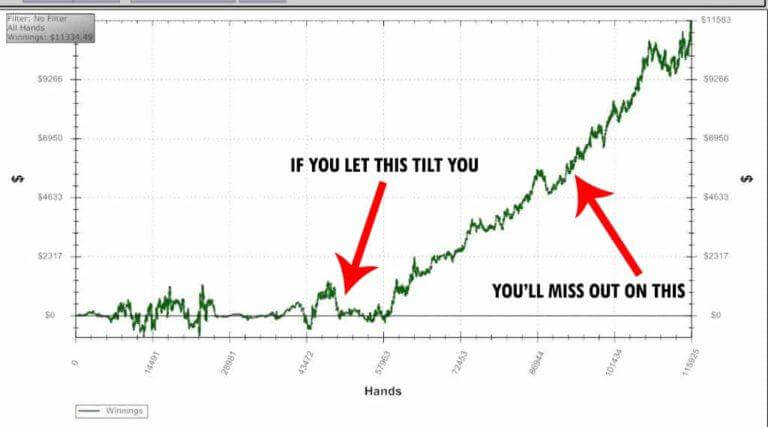Tilt. All poker players know the feeling if not the term. While the origin of the term is debated, it was poker players who made the concept of tilt mainstream.
In this strategy article we will explain how to control and prevent tilt.
Nowadays, the word tilt is used by professional gamers, golfers, even athletes. The concept is simple – some emotional insult or a streak of bad luck has put you so far off your game. You’re so “tilted” that it’s impossible to play like normal.
You start chasing losses and focusing on results, rather than optimal play. Continuing to play while tired and upset, you often lose more and more.
As a matter of fact, some people’s tilt is so bad they actively sabotage themselves when on tilt.
For some, this means spewing buy-ins in bad all-ins. They know they’re beat, but they just want to prove it to themselves. Some professional players are even known to donate their stacks and “ragequit” the table when on tilt.
You could read a hundred strategy articles and improve your game hugely. If you’re a big tilter, you might never win big until you address this underlying tilt problem. And we’re all tilters, so don’t lie to yourself.
Here are five ways I manage to prevent tilt:
Strategy 1: Set a stop-loss and stick to it
A stop-loss is a fixed amount you’re willing to lose. After losing this amount, you force yourself to quit the session. No matter how juicy the tables or how much free time you have, you quit.
You set this amount based on your emotions. How much money can you lose and still stay level headed? For an early career poker player, this number might be 2-3 buy-ins. More senior grinders can lose 5-10 buy-ins and stay level headed.
The most zen of the zen might be able to lose for a week straight without significant consequences. It’s all about where you are with your emotional stability.
Start at 3 buy-ins, and evaluate next time you have a losing session. Set your stoploss just before your losses start affecting your decision making. Set your stop loss, and quit playing once you’ve reached it.
As you mature as a poker player, you can extend the stop-loss further, but only once you’ve dealt with your underlying tilt problem.
The underlying theory is simple: the best way to prevent tilt is to never give yourself the chance to tilt.

The concept of stop losses comes from stock trading. The idea is the same cut your losses before they get too big.
Strategy 2: Time-limit your sessions and take breaks
Even if you aren’t losing, longer sessions can be inherently frustrating. If you’re breaking even, you’ve probably gone up, down, up and down again. You’ve probably grinded out a small profit, and watched it evapourate in 1 or 2 bad pots.
These sessions can tax you emotionally as much as a losing session. To combat this, you should set firm limits regarding how long you plan to play.
As a starting player playing 3-4 tables, 30 minutes is the perfect amount of focus. After this, you can grab a snack, have a coffee, take a shower, go for a walk, and then return to the table if you still want to.
That break, even if just to use the bathroom and get a snack, is crucial to renewing your focus. From there, extend your sessions to 1, and then 1.5, then 2 hours. Frankly, I wouldn’t ever play more than 3-4 hours without a break to eat and unwind.
If you prevent emotional, physical and mental fatigue, I guarantee you will also prevent tilt.
Stick religiously to these rules, only making exceptions in a few situations:
- You have two massive fish at one table
- You have one massive fish on your immediate right
- None of the strong regulars are at your tables, and you are the best player on each table
More important than your poker game, taking breaks is good for your health. At the young age of 23:
- I had developed back pain from poor sitting posture, sitting for too long, and not stretching
- I’d get headaches from ignoring my need to eat healthy meals.
- I gained 15 pounds from grabbing junk food and rushing back to my computer.
- I went from running 5 kilometres daily to barely once a week
- My sleep would suffer because I’d stay up late chasing losses.
Don’t be me. Put yourself before your poker.
I use this quick 6 minute video as a break between sessions every hour to relax myself. This keeps my neck from hurting and relaxes me, keeping me optimally focused on my game. SarahBethYoga also makes wrist, low back, posture and meditation 5 minute videos for your desk:
Strategy 3: Set yourself up for success
Earlier in my career, I had a very bad habit. While on losing sprees, I would go to bed angry (having just lost the evening session).
I’d then wake up, eager to start a new day. Yesterday sucked, and the day before, but today was different. I was going to recoup my losses. I wouldn’t eat, I wouldn’t brush my teeth – sometimes I wouldn’t even use the bathroom. I’d go straight for the computer, load up my tables and start grinding.
Inevitably, I’d lose one, and then two buy-ins. I’d start feeling angry that my dedication wasn’t rewarded. I’d feel like the bad luck had chased me on to new tables, and I couldn’t escape it. I would ignore my stop loss and time limits, and spend the whole day chasing my losses without taking enough breaks. In short, I would spew.
The lesson to be learned here is that setting yourself up for success is on of the best ways to prevent tilt. If you really want to be serious about your grinding, you need to follow this routine before every session:
- Ensure you’ve had a good, well balanced meal
- Get your physical activity in – this could be a 20 minute yoga practice, a 10 minute walk, a run, push-ups/sit-ups. It doesn’t matter what, but don’t put your mind to work without warming up your body first.
- Finish everything you need to before starting your session. This way the nagging reminder that “there’s something else I have to do!” won’t interfere with your poker mindset.
- Create a comfortable, relaxing, ergonomic environment for your grinding free of distractions. That means a good chair, a private space, and a closed skype client and browser. Poker time is private time.
- Take 10 minutes before each session to review your marked hands from the previous session to learn, but also to get yourself in the poker mindset.
You’re probably saying: “I’ve heard all this crap before, but it won’t make me a better poker player.
You’re wrong – I promise you, it will. It wasn’t until I balanced my life that I was able to achieve consistent results. Cognitive research shows that sleeping well, eating well, exercising well and dealing with anxiety and distractions has significant benefits for mental performance and mood.
Strategy 4: NEVER play poker when you aren’t 100%
- You come home after a few drinks with friends, energetic and feeling good.
- You had one hour of sleep last night working on a school project and just came back after a long day of class.
- You just had a big fight with your girlfriend and want to “unwind”
- What do these things have in common?
None of these sentences should EVER come before “and then I began a poker session”.
The easiest way to tilt yourself is to start a losing spree. The easiest way to start a losing spree is to play when you aren’t at your best. So, prevent tilt and protect your bankroll with a firm “no-go” rule for any time you’re not 100%.
And listen up marijuana smokers – what you do on your own time is your own business. But don’t lie to yourselves – you might be worse poker players than drunks!
I once had a student who would lose huge on the weekends, and win big during the weekdays. On weekdays he would be the most disciplined grinder. On weekends he would make the stupidest bluffs and calls imaginable.
After a lot of searching, we found the simple answer: he liked to smoke marijuana on the weekend. During these sessions he would think everyone was bluffing him, level himself and spew money on bad calls. Being high made him paranoid and focused him on one possibility and ignore the rest.
Conclusions
This concludes the preventing tilt portion of our new Poker Psychology series. I understand that the hardest part of overcoming tilt is following this routine even when you’re emotionally shaken.
Dealing with my tilt was difficult, but the first step of the battle is prevention. I have coached players who went from spewing tilt-monkeys to monk-like stone faced sharks. Following this routine religiously made them feel better, tilt less often, or even prevent tilt.
If those monkeys could solve their tilt problems, I promise you can too. Stay tuned for the next part of this series – “Dealing with Tilt” where we focus on managing negative emotions when prevention isn’t possible.

























